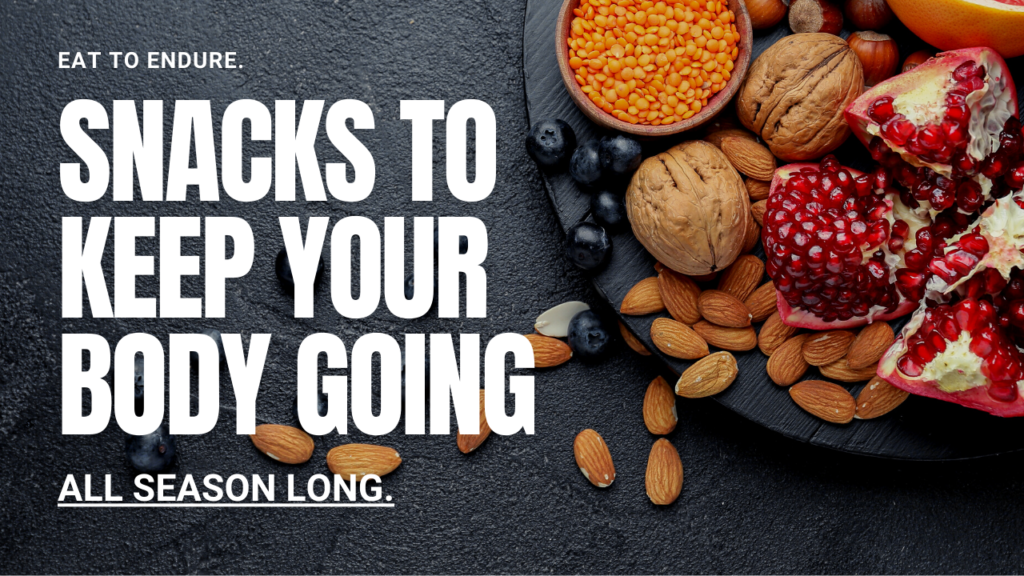A training athlete on-the-go commonly consumes fresh fruit, pretzels, and crackers. However, simple carb-based snacks such as these are usually only beneficial for brief or less intense exercise, as they deliver short bursts of energy. Soccer players and many other young athletes are typically involved in extensive training sessions that last upwards of an hour. Having the energy to start a workout is one thing, but sustaining that energy all the way through to the finish line is fundamental. The most effective way to keep up that stamina is with a comprehensive diet.
The following suggestions incorporate all the necessary components of a nutritious, energy-sustaining snack:
1. Protein: to promote muscle growth and ward off hunger
2. Fiber: to support digestive health and good cholesterol
3. Calories and complex carbs: to provide sufficient, sustained energy
4. Essential nutrients (like calcium, iron, and potassium): to encourage proper development
Which of these hearty snacks would appeal to your all-star?

A quick note- this post is meant as an educational resource only to springboard your research into soccer nutrition. It is not meant to diagnose, treat, cure, or prevent any diseases. Every player is unique and will have different nutritional needs. We highly suggest that players work with a Registered Dietician (RD) for personalized nutritional guidance. TLL is fortunate to have a great RD and certified personal trainer, Kristen Richardson, available to our players. She can work out with clients, understand the demand the workouts require, and also apply the appropriate foods for recovery based on the client’s goals. Sign up to access appointments.
Hummus
Why we love it: Key ingredients in hummus such as chickpeas, olive oil, and sesame seeds are proven to help combat inflammation (helpful for more intense workouts that result in muscle fatigue). These ingredients also contain heart-healthy fats, which contribute to lower risk of heart disease later in life.
Serving suggestion: Pair with pita chips, multi-grain corn chips, or veggie straws for an added serving of carbs.
Downside: Many store-bought hummus brands are high in sodium. Be sure to read the nutrition facts or opt for making your own low-sodium version.
Trail Mix
Why we love it: In addition to its considerable nutritional value, a great feature of trail mix is its potential to be customized. Next time you’re at the store, pick up your favorite nuts (peanuts, cashews, or almonds are popular), seeds (like pumpkin or sunflower), dried fruit (raisins, craisins, or cherries work), and chocolate pieces. When preparing lunches or snacks for the week, personalize a few bags of trail mix to grab on the way to practice.
Serving suggestion: M&M’s are typically the go-to chocolate choice, but dark chocolate chunks have less sugar and more antioxidants. Looking for other sweets to add? Coconut chips can put a tropical twist on any personal blend.
Downside: This snack option requires a bit of preparation ahead of time, so you’ll have to set aside time to build your mix.
Cottage Cheese or Yogurt
Why we love it: Dairy products work as a good source of both protein and carbs. An added bonus is that these products contain a significant amount of probiotics (healthy bacteria), which help support and protect the growing, active body of a young athlete. These snacks also contain enough fat and calories to keep that body moving. Even non-dairy alternatives such as soy or almond-based yogurts offer many of the same benefits, including high calcium and high protein, without the lactose.
Serving suggestion: On their own, yogurt or cottage cheese can be a bit dull. Toss in a few tablespoons of loose granola or chia seeds for added texture and micronutrients.
Downside: For foods of this consistency, a utensil like a spoon is typically necessary. For a truly speedy snack, resort to drinkable or tubed yogurts.
Jerky
Why we love it: Although jerky is traditionally made with beef from cows, vegetarian (and vegan) alternatives are becoming increasingly common. Meatless options of jerky range from fruit based recipes to tofu to mushrooms. Depending on the components, these options can be just as rich in protein and vitamins as typical beef or turkey jerky. Whether you prefer a vegetarian option or not, jerky is an excellent option for a quick, savory bite.
Serving suggestion: Can’t find a non-meat jerky you like? Check out these homemade vegetarian jerky recipes from PETA.
Downside: Like hummus, many store-bought jerkies contain large amounts of sodium. However, higher sodium meals help to replace what was lost with excessive sweating, so this may be a better option for post-game.
Harvest Snaps®
Why we love it: Harvest Snaps® are one of the only true “healthy” chip alternatives because they offer the same crunchy satisfaction, but are made from vegetables instead of conventional starches (corn, potatoes, etc.). They’re seasoned and dried green peas, lentils, and black beans offered in various flavors. Unlike traditional crisps, these snacks are high in plant-based protein and fiber and advertised as GMO, gluten, and artificial colors or flavors-free. They are also widely available at grocery stores like Walmart, Costco, and Publix.
Serving suggestion: Not sure which flavor you’ll like? Harvest Snaps® offers several variety packs of their flavor options (available on Amazon or at your local store). Bring a box for the team to the next game and see which is the fan favorite!
Downside: Kids tend to stray away from foods that are vegetables obviously disguised as treats. In other words, trying to convince your child to eat peas over Doritos may be a bit of a challenge.

Players might even enjoy a combination of the above snacks. For example, jerky and Harvest Snaps® can be dipped in hummus as an alternative to chips or pretzels. Or, cut them into smaller pieces and add to your trail mix. Play around with new and interesting combinations of your favorite healthy snacks to avoid redundancy.
Here are a few closing tips to optimize performance:
– Ideally, you should allow 30-90 minutes for digestion before extended exercise.
– Pair a snack with a beverage high in electrolytes.
– Wash or sanitize hands before eating.
– Don’t forget to drink lots of water!
Reference List (in order of appearance):
Castle, J. (2020, December 5). Healthy snacks for athletes under 18. The Nourished Child. https://thenourishedchild.com/healthy-snacks-list-sports/.
Raman, R. (2018, May 2). Is hummus healthy? Top 8 benefits of Hummus. Healthline. https://www.healthline.com/nutrition/is-hummus-healthy#TOC_TITLE_HDR_7.
Hodgson, L. (Ed.). (2021, March 30). Is hummus healthy? Medical News Today. https://www.medicalnewstoday.com/articles/is-hummus-healthy#nutritional-content.
Eske, J. (2019, March 19). Dark chocolate: Health benefits, nutrition, and how much to eat. Medical News Today. https://www.medicalnewstoday.com/articles/dark-chocolate#anti-inflammatory-effects.
Bacharach, E. (2019, November 7). Vegan jerky is the snack you never knew you needed in your life. Women’s Health. https://www.womenshealthmag.com/food/g29520926/vegan-jerky/.
8 plant-based jerky recipes for your next snack attack. PETA. (2016, October 17). https://www.peta.org/living/food/vegan-plant-based-jerky-recipes-next-snack-attack/.
Holecko, C. (2021, August 9). Your children can still eat healthy snacks for their sports games. Verywell Family. https://www.verywellfamily.com/healthy-half-time-snacks-1257125#citation-2.
